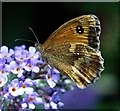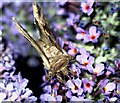1
Evening Sky over Nuthall
Nuthall lies just outside the Nottingham City boundary close to M1 junction 26
Image: © Lynne Kirton
Taken: 5 Jun 2005
0.07 miles
2
Nottingham Road, Nuthall
Taken at noon, New Year's Day 2006. Just outside the Nottingham city boundary, Nottingham Road used to be one of the main routes out of Nottingham to the west until the A610 bypass was built. Looking ESE.
Image: © Lynne Kirton
Taken: 1 Jan 2006
0.07 miles
3
Common Spotted Orchid (Dactylorhiza fuchsii)
This handsome (and definitely wild) specimen suddenly appeared in our back garden! Not its usual habitat, which would normally be open woods, meadows, fens, marshes and scrubland.
Image: © Lynne Kirton
Taken: 10 Jun 2007
0.07 miles
4
Highfield Road
Part of the Temple Nuthall development, started in the late 1930s and continued after the war. This is part of the early development and consists largely of detached houses, many in Tudorbethan style.
Image: © Alan Murray-Rust
Taken: 25 Oct 2009
0.08 miles
5
Storm clouds over Nottingham
Torrential rain, thunder and lightning have just passed over Nuthall, heading towards the city centre for the second day running. One of the main shopping centres, the Broadmarsh, had to be closed the previous day because of flooding.
Image: © Lynne Kirton
Taken: 16 Jun 2007
0.09 miles
6
Small Tortoiseshell (Aglais urticae)
One of our commonest native butterflies, found wherever there are flowers and nettles anywhere in the British Isles, reaching the highest mountain tops and remotest islands, including Shetland. It may often be seen basking on brambles. There are usually two broods a year, the later one of which will hibernate over the winter. It is also common and widespread throughout Europe.
Image: © Lynne Kirton
Taken: 21 Jul 2006
0.10 miles
7
Red Admiral (Vanessa atalanta) underside
One of Britain's largest & most vividly marked butterflies, the Red Admiral arrives from late May onwards, spreading throughout the British Isles including the larger islands. The underside of the forewing is a duller version of the upperside and generally quite conspicuous, although when roosting it is pulled down between the underwings so that only the dark tip is visible. The butterfly is then camouflaged to resemble tree bark. The Red Admiral is unable to tolerate British winters and there is some evidence of a return migration to the Continent. However, many, probably most, try to hibernate and almost invariably perish.
Image: © Lynne Kirton
Taken: 21 Jul 2006
0.10 miles
8
Gatekeeper (Pyronia Tithonus) underside
Also known as the Hedge Brown, the Gatekeeper is common in all southern counties of England, and in lowland Wales, wherever wild grasses and shrubs grow together, but is absent from Scotland. It is sometimes confused with the much larger Meadow Brown which has less orange and only one white pupil in the eyespot on the upperwing. They seem to like yellow flowers in particular, & so may often be found on ragwort or fleabane. See also
Image
Image: © Lynne Kirton
Taken: 23 Jul 2006
0.10 miles
9
Peacock butterfly (Inachis io)
A spectacular resident butterfly, common throughout the British Isles except for northern Scotland. They hibernate over the winter and lay their eggs on stinging nettles. The underwings are in complete contrast to the upperwings, being very dark, almost black, and beautifully camouflaged to resemble tree bark.
Image: © Lynne Kirton
Taken: 23 Jul 2006
0.10 miles
10
Silver Y moth (Autographa gamma) on buddleia
A regular early summer migrant from Europe which often comes north in enormous swarms and multiplies rapidly. Named for the silvery white Y shaped marking on the upper forewings. Both day and night flying, and abundant in Britain in the autumn, but cannot overwinter here. The picture was taken at dusk and there were between 20 and 30 of these moths hovering at the buddleia flowers. They seldom settled and behaved like tiny humming birds sucking out the nectar. Flash had to be used to provide sufficient light and to freeze the action!
Image: © Lynne Kirton
Taken: 18 Jul 2006
0.10 miles











